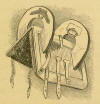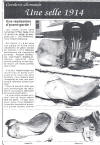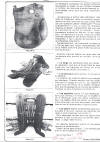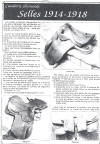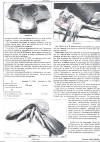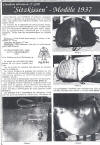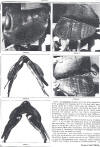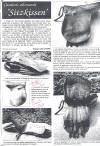Military Research
|
The Italian Cavalry Charge Against British Tanks!
There is a common
myth that the Polish cavalry made a desperate attack against German
tanks. Such an event never took place. But in January 1941, Baron Alfredo
Guillet, known as the Italian “Lawrence of Arabia,” led a cavalry charge
against British tanks in North Africa. Details of this extraordinary, but
largely forgotten, episode were recorded by noted equestrian historian
Tootoo Imam. |
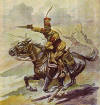 |
|
LRGAF Publishes Historic Study on Pack Saddles (PDF) The Long Riders’ Guild Academic Foundation is proud to publish the first extensive study done regarding the use of equine pack transportation during the American Revolutionary War, 1776 to 1781. This ground breaking research was undertaken by the scholar John U. Rees, who spent years uncovering a treasure trove of facts and images about this overlooked part of equestrian history. John’s detailed report, which contains extensive footnotes and a long list of primary sources, is the first detailed investigation into how equestrian travel influenced the outcome of the Revolutionary War. The image (right) depicts the pack saddle used by General George Washington during the conflict with Great Britain. |
Equestrian Deception – After the Japanese bombed Pearl Harbor, the Americans vowed revenge. One of the strangest demonstrations of that national obsession was the country’s determination to capture the white charger ridden by Emperor Hirohito. According to propaganda widely circulated at the conclusion of the war, the legendary horse was paraded in triumph across the United States. Yet LRGAF researcher Judi Daly has uncovered evidence indicating that the Emperor’s horse was never captured and that an elaborate equestrian deception was perpetrated on the public.
In Defense of the Horse: Major-General John K. Herr, Chief of Cavalry – With the rise of the motorized age, the majority of politicians were calling for the disbanding of the American mounted forces. Sadly, many officers agreed with this short sighted decision. Not General Herr. He fought a heroic defense of the mounted soldier, arguing that the tactical strengths of the cavalry charger, and the pack mule, could be adapted to modern warfare. Though Herr was out voted, and the cavalry disbanded, recent events in Afghanistan have proved him right. Robert Seals, a retired Army Special Forces officer who has previously documented other cavalry events, has produced a special report for the LRGAF which thoroughly explains Herr’s attempts to keep the US army mounted.
The Horse that led Lahore to War – There have been many stories of mighty horses who went to war, but none were so magnificent that they inspired not one, but two wars to be fought over them. Asl-I-Laila was the horse of such legendary beauty that his owner hung the famous Koh-I-Noor diamond round his neck.
A Day in the Life of a Cavalry Troop Horse – Thanks to a former Cavalry general in India, this timeless illustrated story explains how the mount of an ordinary sowar saw life back in the days of the Bengal Lancers.
The Remarkable Ride of General Miles – It was the summer of 1903. The temperature was soaring around the 100 degree mark. The man in the saddle was sixty-three years old and his employer, the US Army, was forcing him to retire in a few months time. Ahead of him were two options. He could either fade into obscurity or he could ride 90 miles from Fort Reno to Fort Sill, just to prove that he still had the grit that had made him famous. Could Medal of Honour recipient General Nelson Miles, who had served in the Civil War, the Indian Wars and the Spanish-American War make such a ride? He could – and he did !
In Defense of Honor: General Douglas MacArthur and the Horse Cavalry of 1934. In 1995 one of the most historically inaccurate equestrian movies ever made was released. Entitled In Pursuit of Honor, the film could more accurately have been entitled Hollywood's Pursuit of Money. The film purports to relate the story of how five renegade American cavalry officers drove a herd of 400 horses from Mexico to Canada, while being hotly pursued by mechanised opponents. Not only was the movie filled with falsehoods, it slandered General Douglas MacArthur and the officers of the US cavalry. A Hollywood producer recently told the press, "What does it matter? Accuracy is not something that concerns ordinary people." In response, Bob Seals, a retired Special Forces officer, has demonstrated in this excellent academic article that ordinary people do indeed very much care about historical accuracy.
During the 19th century, at the height of what was known as "The Great Game," British military operatives captured and translated a Czarist equestrian report which provided unprecedented details regarding the horses of Central Asia. Rediscovered by the LRGAF, and released for the first time in more than a hundred years, you can now read this Russian Military Study by Lev Feofilovich Fostenko translated by Walter Gowan of British Military Intelligence in Simla, India, in 1883.
The LRGAF is proud to
begin publication of a series of many fascinating, forgotten (and now
unobtainable) chapters from the British Cavalry Journal from the early 1920s.
To start with, there are two extracts from
Militarie Instructions for
the Cavallrie,
by John Cruso,
published in the year 1644,
compiled by Lieut.-Colonel F.H.D.C. Whitmore, C.M.G., D.S.O., T.D.
- CHAPTER I. - Of Officers in generall.
- CHAPTER XVI. - Of distributing bootie.
In addition, here is the story of an amazing woman who disguised herself as a mounted warrior - Trooper Christiana Davis, 6th (Inniskilling) Dragoons by Lieut.-Colonel Sir Arthur Leetham, C.M.G.
Soon after Caprilli launched his revolutionary jumping style in 1920s Italy, a talented British cavalry officer was offered the opportunity to ride in the Italian Cavalry School. Though the Italians modestly claimed not to be "a nation of horsemen," the British officer had some hair-raising adventures. Read Impressions of the Italian Cavalry School at Pinerolo by Captain P.E. Bowden-Smith, 4th Queen's Own Hussars, who declined an offer to jump his horse out of a castle window and down a sheer cliff.
Mules for China contains a description of the difficulties encountered, and lessons learned, when American officers attempted to herd 900 mules nearly a thousand miles from Burma into China in 1945.
Belgian Long Rider Robert Wauters has written a series of articles in French about saddles from the English, Belgian and German cavalry from 1868 to 1943. Few people know that these European cavalrymen were using treeless saddles and saddles with articulated trees so long ago!
(Click on any image to enlarge it.)
|
La Selle 1868 - The Belgian Cavalry Page 1 |
"This saddle is almost unknown in the current equestrian community." Page 2 |
Une Selle 1914 - The German Cavalry Page 1 |
"What is amazing about this saddle is that the tree is made entirely of steel." Page 2 |
Arçons à patins articulés 1915 - The English Cavalry "Saddle with a flexible tree." |
|
Selles 1914-1918 - The German Cavalry. Page 1 |
"This saddle of remarkable quality has many advantages. Page 2 |
Sitzkissen - Modèle 1937 - The German Cavalry Page 1 |
"This treeless saddle is similar to the 1943 model (right) Page 2 |
"This treeless saddle was designed for horses which were too big for standard saddles." |
Thanks to the incredible generosity of the American Quartermaster Museum, the LRGAF has launched the American Cavalry Blueprint Library. This extraordinary collection of more than 250 military documents reveals details of the legendary McClellan riding saddle and the famous Phillips pack saddle, as well as all of the items once used on a daily basis by mounted troopers, including bridles, saddlebags, hobbles, stirrups, picket pins, farrier tools and hundreds of other cavalry paraphernalia.
Depending on who you talk to, Colonel George Armstrong Custer was either a military genius or a glory-hungry madman. The debate began in 1876, soon after the American cavalry officer led the Seventh Cavalry into the fatal “Battle of the Little Big Horn.” Yet while films and books have often depicted Custer as a dashing but doomed hero, these popular accounts failed to study the officer’s equestrian decisions. Thanks to the academic assistance of Brigadier General Doctor Thomas Murnane, the LRGAF is able to present the most extensive equestrian study ever undertaken into “Custer’s Last Stand.” The enlightening document entitled, Marching with Custer was published in 1941 by Colonel Elwood Nye. Nye, who spent years studying Custer and excavating at the battle site, concluded that Hollywood got it all wrong when it came to the horses.
When the news was announced in 1938 that the US Army was putting its horses out to pasture in favour of mechanization, a determined cavalry officer reacted by announcing that he would lead the last official cavalry expedition across the Great Plains. Twilight of the Cavalry, describes how that courageous officer led 600 troopers nearly a thousand miles on that historic mounted mission.
One of the last great cavalry charges took place 90 years ago at Moreuil Wood. Brough Scott (one of the best known figures in horse racing and whose grandfather led the field) tells the story of the special horse who fearlessly carried the general into battle.
Japanese Horse Cavalry by Major Hal. D. Steward
News dispatches from Northern China at the end of World War II reported that the Russians had captured 16,500 horses from the Japanese Army in that region. Recently revealed Jap documents establish the fact that these horses came from two Japanese cavalry brigades that had been stationed in Northern China all during the war. One of the brigades had been in Manchuria since 1932.
The two Japanese cavalry brigades were the Third Brigade (mounted) consisting of the 23d and 24th Cavalry Regiments, brigade artillery, a machine-gun unit of two companies, a signal unit and a transport battalion; and the Fourth Cavalry Brigade (horse-mechanized) composed of the 25th and 16th Cavalry Regiments, brigade artillery, a machine-gun unit of two companies, a signal unit and a transport battalion. Both brigades, according to Japanese Tables of Organization, had more than 3,000 horses.
